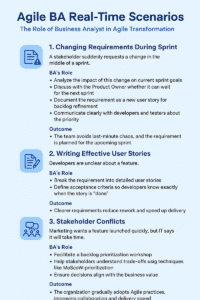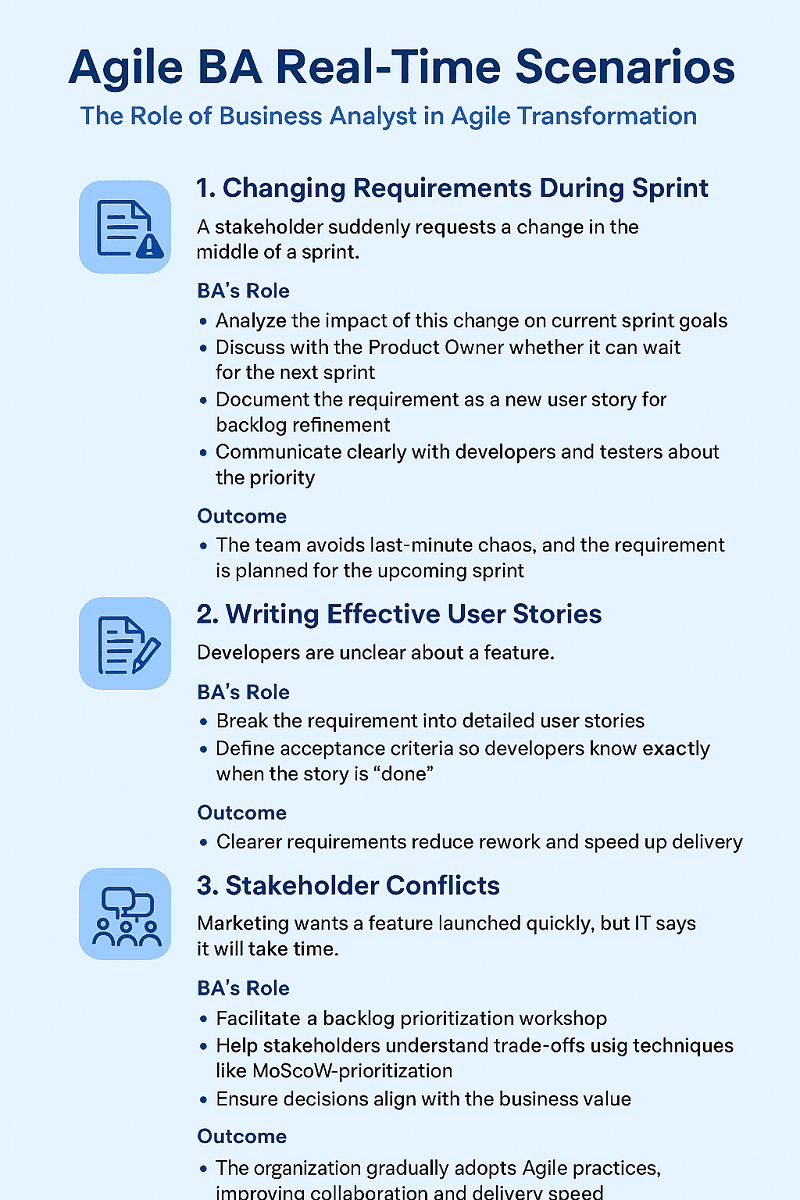In today’s fast-changing business environment, organizations are moving away from traditional project delivery methods and adopting Agile practices. Agile allows teams to deliver faster, adapt to change, and focus on customer value. A Business Analyst (BA) plays a critical role in this journey. In fact, Agile BAs act as a bridge between business needs and technical teams, ensuring that what is delivered truly solves customer problems.
In this article, we’ll explore:
-
The role of Business Analysts in Agile
-
Real-time Agile BA scenarios
-
Examples of how BAs handle challenges in Agile projects
-
The importance of BAs in Agile Transformation

What is the Role of a Business Analyst in Agile?
In Agile, Business Analysts are not limited to writing lengthy documents. Instead, they focus on collaboration, communication, and continuous improvement.
Key responsibilities of an Agile BA include:
-
Understanding business needs – Identifying what stakeholders truly require.
-
Breaking down requirements – Writing user stories and defining acceptance criteria.
-
Collaboration – Working with Product Owners, Scrum Masters, developers, and testers.
-
Facilitating workshops – For eliciting requirements, prioritizing features, and resolving conflicts.
-
Supporting Agile Transformation – Helping the organization adopt an Agile mindset by bridging business and IT.
👉 Related: Agile Methodology for Business Analysts
Agile BA Real-Time Scenarios with Examples
Let’s look at some real-world examples of how Business Analysts work in Agile projects.
1. Scenario: Changing Requirements During Sprint
Situation: A stakeholder suddenly requests a change in the middle of a sprint.
-
For example, in an e-commerce project, the client decides to add a new payment method halfway through development.
BA’s Role:
-
Analyze the impact of this change on current sprint goals.
-
Discuss with the Product Owner whether it can wait for the next sprint.
-
Document the requirement as a new user story for backlog refinement.
-
Communicate clearly with developers and testers about the priority.
Outcome:
The team avoids last-minute chaos, and the requirement is planned for the upcoming sprint.
2. Scenario: Writing Effective User Stories
Situation: Developers are unclear about a feature.
-
For instance, “Search functionality” is too vague. Should it search by product name, category, or price?
BA’s Role:
-
Break the requirement into detailed user stories like:
-
As a user, I want to search by product name so that I can quickly find what I need.
-
As a user, I want to filter results by price range so that I can shop within my budget.
-
-
Define acceptance criteria so developers know exactly when the story is “done.”
Outcome:
Clearer requirements reduce rework and speed up delivery.
👉 External Resource: User Story Writing Best Practices – Atlassian
3. Scenario: Stakeholder Conflicts
Situation: Marketing wants a feature launched quickly, but IT says it will take time.
BA’s Role:
-
Facilitate a backlog prioritization workshop.
-
Help stakeholders understand trade-offs using techniques like MoSCoW prioritization (Must-have, Should-have, Could-have, Won’t-have).
-
Ensure decisions align with the business value.
Outcome:
Both teams agree on priorities, and delivery stays aligned with organizational goals.
4. Scenario: Agile Transformation Challenges
Situation: An organization is moving from a traditional Waterfall model to Agile. Many employees resist change.
BA’s Role in Agile Transformation:
-
Act as a change agent by explaining the benefits of Agile.
-
Conduct training sessions to help teams understand Agile ceremonies like Daily Stand-ups, Sprint Planning, and Retrospectives.
-
Ensure business stakeholders actively participate in reviews and planning.
-
Show how Agile provides faster feedback and better customer satisfaction.
Outcome:
The organization gradually adopts Agile practices, improving collaboration and delivery speed.
👉 Related: Agile Transformation: A Complete Guide
Tools and Techniques Agile BAs Use
Agile BAs often rely on tools and techniques to manage requirements and communication effectively:
-
JIRA / Azure DevOps – For backlog management and user stories.
-
Confluence / Miro – For documentation and collaboration.
-
SWOT Analysis – To evaluate risks and opportunities.
-
Business Process Modeling (BPMN) – To visualize workflows.
👉 Related: Business Process Modeling Techniques
Why Business Analysts are Critical in Agile Projects
Without a Business Analyst, teams risk building features that don’t solve real business problems. Agile BAs ensure that:
-
Requirements are clear and prioritized.
-
Stakeholder expectations are managed.
-
Agile adoption is smoother through continuous collaboration.
-
The product delivers value, not just functionality.
Final Thoughts
Agile BA real-time scenarios show how critical the role of Business Analysts is in today’s Agile projects. From handling changing requirements to facilitating stakeholder collaboration, BAs ensure that Agile teams deliver value consistently. More importantly, during an Agile Transformation, Business Analysts act as change leaders who guide organizations towards agility.
If you are a business analyst fresher or professional, understanding these scenarios will help you perform better in interviews and real projects.

Business Analyst , Functional Consultant, Provide Training on Business Analysis and SDLC Methodologies.


Helpful and well-paced. Looking forward to your next post.
This is an absolute gem of an article. It’s rare to find such high-quality content online.